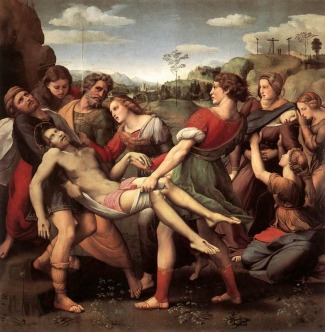Raphael (Raphaello Sanzio)
Biography
Raphael was an Italian painter and architect during the time of the Italian High Renaissance. One thing that his works are famous for are there “visual achievement of the Neoplatonic ideal of human grandeur.” Raphael’s father, Giorgio Vasari, was a painter, but not very well known. He gave Raphael his first painting lesson, and introduced him to the philosophies of art that he had learned. Raphael’s home town of Urbino provided the basis for his learning, although he was later influenced by accomplished artists in Florence and Rome. He also apprenticed in a town called Perugia where he began to learn about painting frescoes. He soon created his first work called The Marriage of the Virgin which was inspired by the Giving of the Keys to St Peter, painted by Perugino for the Sistine Chapel of the Vatican Palace. Raphael followed the Perugian painter Bernardino Pinturicchio to Siena and then went on to Florence, because he was inspired by the works of Leonardo da Vinci and Michelangelo, who were working in that city. He created several works inspired by Leonardo and Michelangelo. Raphael was later called to Rome by Pope Julius II because the architect Donato Bramante wanted Raphael to work on some projects there. Raphael made what was probably his greatest work while staying in Rome. It was the decoration of the Stanza della Segnatura. He spent the last 12 years of his life in Rome making many great pieces of art.
Spozalizio (The Engagement of Virgin Mary)

This was Rapael's first major work. It was inspired by the works of Perugino. The emphasis on perspectives, the relationship between figures, and the relationship between figures and architecture is where one can greatly see where the inspiration from Perugino came from.
Deposition (Entombment)

This painting greatly portrays the influence that Michaelangelo had on Raphael's work. I was painted in 1507 in Perugia for Atalanta Baglioni in memory of her son, Grifonetto who was killed in Perugia. Instead of following the traditional representation of this scene, which was the actual deposition, Raphael instead depicted the dead Christ being carryed. The painting was carried by Pope Paul V from Perugia to Rome where it remains today.
Stanza della Segnatura

This was the first of Pope Julius II's rooms in the papal appartments to be decorated with Raphael's frescoes. His art brings together the spirits of Antiquity and Christianity. The different paintings on each of the walls of this room are known as the Disputation of the Holy Sacrament, the School of Athens, the Parnassus, and the Virtues.
